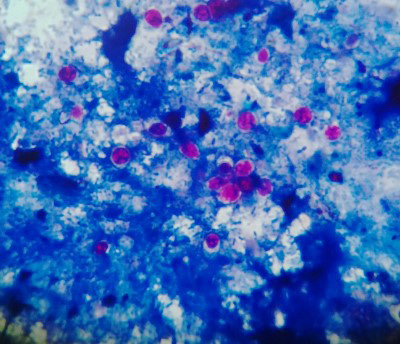Prevalence of cryptosporidiosis in humans and calves and molecular detection of Cryptosporidium parvum
Prevalencia de la criptosporidiosis en seres humanos y terneros, y detección molecular del Cryptosporidium parvum


This work is licensed under a Creative Commons Attribution-NonCommercial-ShareAlike 4.0 International License.
Show authors biography
Objective. To investigate of the prevalence of Cryptosporidium species in humans and calves in the province of Van, Turkey. Materials and methods. Included in this research were 150 patients, comprising 50 hemodialysis patients, 40 immunosuppressed patients with diarrhea, 30 patients with diarrhea only, and 30 immunocompetent patients. Collected were stool rectal samples from 50 calves that were housed in stables and farms in 10 central villages of Van, Turkey. Results. Cryptosporidium parvum was detected in 17.3% of the 150 human stool samples. C. parvum was observed in 20% of the 50 samples from the hemodialysis patients, 32.5% of the 40 samples from the immunosuppressed patients with diarrhea, and 10% of the 30 samples from patients with diarrhea only, whereas no Cryptosporidium spp. was detected in the samples from the immunocompetent patients. C. parvum was observed in only 6% of the samples from the diarrheic 30 calves. Conclusions. It was clearly understood that cryptosporidiosis was detected at a high rate in the samples from the immunosuppressed patients and those who were immunosuppressed with diarrhea, and that the active and effective species that causes cryptosporidiosis in the Van region is C. parvum. Hence, these patient groups should be evaluated in terms of cryptosporidiosis.
Article visits 959 | PDF visits
Downloads
- Fayer R, Xiao L. Cryptosporidium and Cryptosporidiosis. 2nd ed. London: CRC press; 2008.
- Laurent F, Lacroix-Lamandé S. Innate immune responses play a key role in controlling infection of the intestinal epithelium by Cryptosporidium. Int J Parasitol. 2017; 47:711–721. https://doi.org/10.1016/j.ijpara.2017.08.001
- Xiao L. Molecular epidemiology of cryptosporidiosis: an update. Experimental Parasitology. 2010; 124:80-89. https://doi.org/10.1016/j.exppara.2009.03.018
- Ryan U, Fayer R, Xiao L. Cryptosporidium species in humans and animals: current understanding and research needs. Parasitology. 2014; 141:1667-1685. https://doi.org/10.1017/S0031182014001085
- Ryan U, Paparini A, Oskam CC. New technologies for detection of enteric parasites. Trends Parasitol. 2017; 33(7):532–546. https://doi.org/10.1016/j.pt.2017.03.005
- Mirhashemi ME, Zintl A, Grant T, Lucy FE, Mulcahy G, De Waal T. Comparison of diagnostic techniques for the detection of Cryptosporidium oocysts in animal samples. Experimental parasitology. 2015; 151:14-20. https://doi.org/10.1016/j.exppara.2015.01.018
- Yilmaz H, Cengiz ZT, Çiçek M. Investigation of cryptosporidiosis by enzyme-linked immunosorbent assay and microscopoy in children with diarrhea. Saudi Medical Journal. 2008; 29(4):526. https://smj.org.sa/content/29/4/526
- Ekici A, Ünlü A, Halidi AG, Aydemir S, Yilmaz H. Determınatıon Of The Occurrence Frequency Of Cryptosporıdıum Sp. In Chıldren Brought To The Hospıtal Wıth The Complaınt Of Dıarrhea Usıng Dıfferent Methods. Applıed Ecology And Envıronmental Research. 2021; 19(4):2905-2913. http://dx.doi.org/10.15666/aeer/1904_29052913
- Körkoca H, Yasar G, Atas AD, Kurtoglu Mg, Ekici K, Berktas M. Prevalence of Cryptosporidium spp. in asymptomatic food workers. Turkish Journal of Parasitology. 2013; 37(4):241. https://doi:10.5152/tpd.2013.2981
- Ciçek M, Körkoca H, Gül A. Investigation of Cryptosporidium sp. in workers of the Van municipality slaughterhouse and in slaughtered. Animals. 2008; 32(1):8-11. https://www.turkiyeparazitolderg.org/archives/archive-detail/article-preview/van-belediye-mezbahasnda-alan-iilerde-ve-kesimi-ya/22898
- Ayan A, Kilinc OO, Yuksek N, Basbugan Y. Detectıon of Cryptosporıdıum spp. in calves through nested Pcr And Kınyoun’s Acıd-Fast Methods In Van, Turkey. IJEES. 2020; 10(2):271-276. https://doi.org/10.31407/ijees10.205
- Korkmaz M, Ok Ü. Parazitolojide laboratuvar. Turkish Parasitology Association. İzmir, Turkey; 2011.
- Sadek GS. Use of nested PCR-RFLP for genotyping of Cryptosporidium parasites isolated from calves and children suffering from diarrhea. Parasitol United J. 2014; 7(2):129–137. https://doi.org/10.4103/1687-7942.149568
- Akdemir C. Investigation of cryptosporidiosis by serologic and microscopic method and examination of tap water samples for oocysts. Turkiye Parazitol Derg. 2013; 37:9–12. https://doi.org/10.5152/tpd.2013.03
- Yousry Hawash LS, Dorgham A, Mohammed, S. Prevalence of Cryptosporidium-associated diarrhea in a high altitude-community of Saudi Arabia detected by conventional and molecular methods. Korean J Parasitol. 2014; 52(5):479–485. https://doi.org/10.3347/kjp.2014.52.5.479
- Karaman Ü, Daldal N, Özer A, Engiyurt Ö, Ertürk Ö. Incidence of Cryptosporidium spp. in the human population of Malatya in Turkey. Acta Medica. 2015; 31:263–269. http://abakus.inonu.edu.tr/xmlui/handle/123456789/15700
- Nassar S, Oyekale T, Oluremi A. Prevalence of Cryptosporidium infection and related risk factors in children in Awo and Iragberi, Nigeria. J Immunoassay Immunochem. 2017; 38(1):2–9. https://doi.org/10.1080/15321819.2016.1178652
- Karli A, Metin A, Ergen S, Simsir H, Köse G. The incidence of Cryptosporidium infection in children with diarrhea. Çocuk Enfeksiyon Dergisi. 2013; 7(3):92–96. https://doi.org/10.5152/ced.2013.27
- Saksirisampant W, Prownebon J, Saksirisampant P, Mungthin M, Siripatanapipong S, Leelayoova S. Intestinal parasitic infections: prevalences in HIV/AIDS patients in a Thai AIDS-care centre. Annals of Tropical Medicine & Parasitology. 2009; 103(7):573-81. https://10.9775/kvfd.2010.2140
- Börekçı G, Otağ F, Emekdaş G. Mersin’de bir gecekondu mahallesinde yaşayan ailelerde Cryptosporidium prevalansı. Journal of Infection. 2005, 19(1):39-34. http://infeksiyon.dergisi.org/summary_en.php3?id=105























